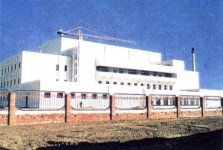 The
TheNuclear
Information
Project
 The TheNuclear Information Project |
FAS | Nuke | Guide || Search | Join FAS |
Algerians asserted that the reactor was intended to produce only radioactive isotopes for medical research and to generate electric power. However, the secrecy surrounding the program, which had been initiated in 1986, raised suspicions. Algeria was not a signatory to the Nuclear Non-Proliferation Treaty (NPT) at the time, having rejected it on the principle that Algeria should not have to renounce a nuclear weapons program when other nations could continue with theirs.
The Algerian government established the Commissariat for New Energy (Commissariat aux Énergies Nouvelles) in 1982 to develop nuclear energy, solar energy, and other potential sources of power. Whereas solar power proved to have considerable potential, particularly in desert locations, nuclear power became a casualty of international concerns and allegations that it could be used for military purposes. Algeria was thought to want nuclear weapons to counter a perceived threat from the radical regime of Libya's Col. Moammar Gadhafi. It is reported that secret agreements were signed by Algeria with China and Argentina at the beginning of the 1980s to produce weapons grade plutonium. Under a secret 1983 agreement the Chinese government provided the nuclear reactor to Algeria, which along with a related research facility could form the central components of a weapons program. In 1984, Algeria purchased 150 tons of uranium concentrate from Niger. It was reported that Iraq had sent scientists and some uranium to Algeria. Algeria's efforts to reform one of the most centrally planned economies in the Arab world began after the 1986 collapse of world oil prices plunged the country into a severe recession. In 1989, the government launched a comprehensive program to introduce market mechanisms into the economy. Despite substantial progress toward economic adjustment, in 1992 the reform drive stalled as Algiers became embroiled in political turmoil, and in September 1993, a new government was formed.Under pressure from the United States, Algeria accepted safeguards from the International Atomic Energy Agency (IAEA) in February 1992. The El Salam reactor began operating in late 1993. Algeria joined the NPT in January 1995 as a non-nuclear weapon state, and agreed to inspection of the site by the IAEA. The IAEA inspections discovered that three kilograms of enriched uranium, several liters of heavy water, and several pellets of natural uranium supplied by China had not been declared to the IAEA.
On April 11, 1996, Algeria joined many countries on the African continent in signing the Treaty of Pelindaba, which established a nuclear-weapons free zone in Africa, ratifying the Treaty on February 11, 1998. The Treaty of Pelindaba went into effect on July 15, 2009.
